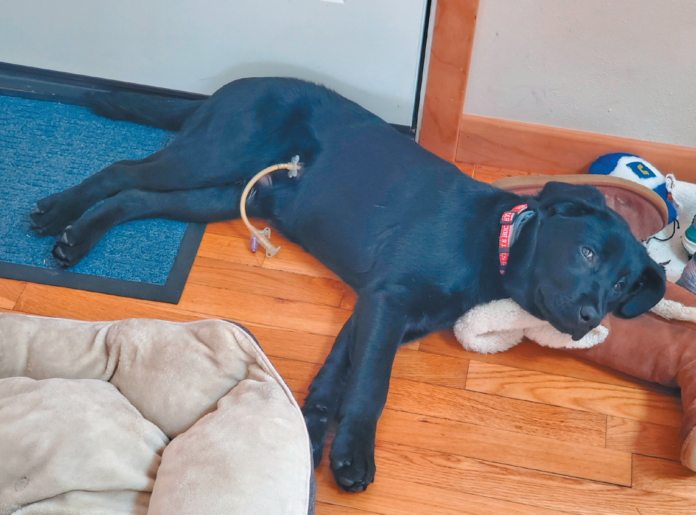The term “feeding tube” may conjure up an image of a terminally ill dog who’s so sick he doesn’t have the strength to swallow his own food and needs to have his nutrients delivered with a medical device as he heads toward death. But for most dogs sent home with a feeding tube in place, it’s simply a measure to make sure they continue to receive nourishment while they are recovering from an illness that doesn’t allow them to take food by mouth.
For instance, a dog may have swallowed a bone or other sharp object and needs time for his esophagus to heal before he is able to safely and comfortably swallow again. Or he may have had extensive oral or facial surgery that makes it temporarily impossible to chew and get food down.
Granted, sometimes a dog has chronic kidney or liver disease and needs a feeding tube because nausea or other symptoms make him less willing to eat. But even then, while the feeding tube won’t bring him back to good health, it can prolong his quality of life. Whatever the situation, a veterinarian’s suggestion of a feeding tube is not something that should make you shudder. And you’re definitely up to the task of feeding your dog through the tube and keeping it clean at home.
Two main kinds of feeding tubes
Should your dog be unable to eat by mouth for more than three to five days, the doctor will recommend one of two types of feeding tubes.
E-Tube. The “E” is short for “esophagostomy,” meaning an E-tube is placed directly into the esophagus through the neck. It’s about as thick as a pen. The visible part is about 6 inches long, and the rest of the tube extends down the esophagus and is not visible. The dog has to be anesthetized for the placement, but just very briefly.
G-Tube. The “G” stands for “gastrostomy,” meaning a G-tube goes directly into the stomach through the abdominal wall. It is called for when the esophagus is not working properly, say, as the result of decreased motility or an obstruction that cannot be removed at present. Placing it is a little more involved, involving either surgery or endoscopic guidance. But it’s not terribly risky as procedures go. One thing worth noting is that with a G-tube, a dog will have to wear an Elizabethan collar, at least at first, because it’s too easy for his mouth to reach the spot and begin licking and tearing at the tube or the small wound created when the tube is placed.
How the actual feeding goes
In virtually every situation, you will be able to feed commercially available canned dog food. Sometimes it can even come from the supermarket instead of via prescription. Generally, you have to blend it with a specific amount of water so it turns into a slurry that can be easily injected into the tube. And you’ll probably be told to warm the food before feeding.
Feedings should be done slowly, usually taking at least 5 to 10 minutes. And they need to occur three to four times a day. The dog can only take so much at one time.
The tube should always be flushed with warm water before and after each feeding to prevent clogging. Making sure the tube stays capped between feedings is important, too. You want to keep out debris and also keep the tube from drying out. That helps prevent clogging also.
Tube maintenance
If your dog has an E-tube, you’ll be instructed to keep a pad around the base of it and will need to change it regularly for optimum hygiene. There will also be a wrap that covers the site at which the tube enters the neck.
A G-tube also requires a pad, along with bandage changings. And you’ll need to check the site daily to make sure there’s no redness, swelling, discharge, or other sign of possible infection. If things don’t look right, it’s important to call the vet.
The routine won’t last forever. Most dogs have a feeding tube anywhere from a couple of weeks to a few months, although there are cases where a G-tube is left in permanently. If a dog has a permanent motility problem in his esophagus, for example, he will always need his calories to enter his body further down. But you’ll become a pro at feeding him through his tube in no time.





